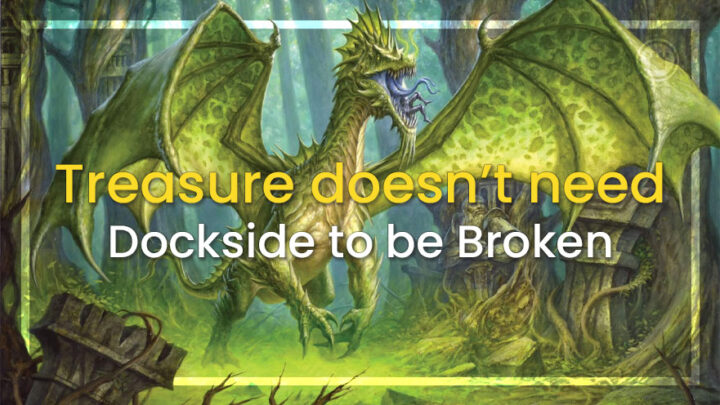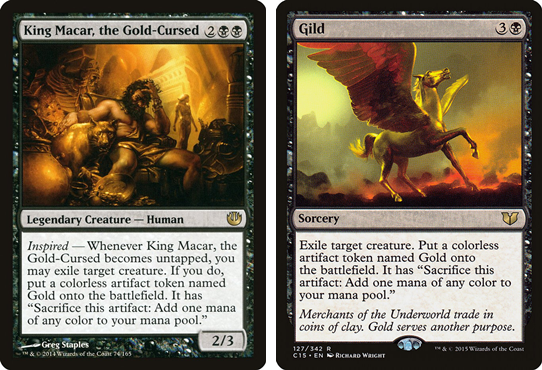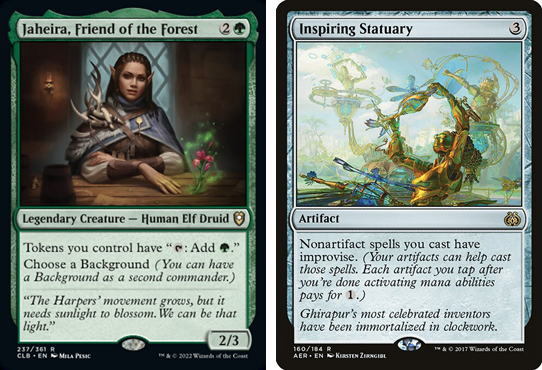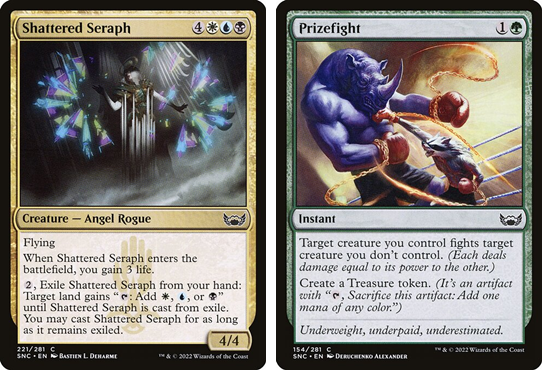Treasure fundamentally changed Magic. Kristen muses on its current place in Limited and Commander, considering if it’s too powerful.
When Treasure first arrived on the scene, it seemed innocent enough. “Sailor of Memes” was the standout, well, meme from Ixalan block, and our experience at that point showed it was new and interesting, provided fixing in a limited environment that otherwise really stuck you into specific decks and had a few neat pieces for Commander. Looking back, I’m sure we all wish we’d picked up more copies of Pitiless Plunderer, right?
Trove of Temptation
Before, Treasure was Gold. This mechanic wasn’t used very extensively at all, and I think we can be thankful for that, in hindsight. It was conditional on using (at the time) a limited number of ways to tap King Macar outside of combat, which was much riskier.
Gild was a removal spell printed for Commander back when black had far less to work with and exile removal was still more expensive. Clearly, something put R&D on edge about Gold, though, because outside of Commander 2017’s Curse of Opulence, we haven’t seen it since.
Gold tokens were replaced with Treasure because, essentially, Treasure must be tapped in order to gain the mana. At the time of Gold’s introduction, there were a number of ways to take advantage of extraneous artifacts you could tap, but that’s nothing compared to what came after. Having Treasure tap as part of the ability was future-proofing…
…at least, until it wasn’t. Though lessons were learned with Urza, Lord High Artificer — and the subsequent wording of “nontoken artifact” on Meria, Scholar of Antiquity — it seems we can’t escape the many ways to lean into treasures and really rinse them for all they’re worth. Jaheira and Inspiring Statuary are two of the grossest offenders when it comes to Treasure, letting you turn them into some kind of Moxen meets Lotus Petal, which is exactly as powerful as it sounds.
This kind of interaction is known as an “unfair” synergy in EDH, at least by method of exclusion. It’s definitely not what is commonly referred to as “good, fair Magic” by any means. “Good, fair Magic” is, like most Commander terms, nebulous, but roughly speaking, it alludes to playing a game of Magic that enjoys the mana system, tempo and traditional, color-pie archetypes, without attempting to break parity too egregiously.
It’s entirely traditionalist, and though I have to say I enjoy games that engage with the fundamentals of Magic as a game system fully (with the combat step being super important), it’s just not how the majority of games are played with 2022 card design.
Parity can be broken in Commander on multiple axes, and it’s how decks win games. You have to pull ahead at some point, and it’s why I’ve written before on how White’s problem in Commander is that it lacks explosiveness compared to the other colors. But if this is what all decks must do to win, why does everyone hate Smothering Tithe?
Smothering Tithe
When Smothering Tithe released, I was still in my mostly-mono white Commander phase. I played predominantly white or Boros, and I snapped up half a dozen of these straight away, knowing they would go up in price immediately. It’s not as galaxy brain as buying up dollar mythic Arclight Phoenixes, but I’m a Commander and Limited player at heart, so I’ll let myself off for that.
Smothering Tithe answered many problems non-green White decks faced in the format when it released. It gave white decks ramp, and it did it in a way that felt ostensibly white in flavor. Rhystic Study had been argued to be a white effect for years, and finally there was precedence for it.
We didn’t know it at the time, but Tithe was a spike in power for white card design that we wouldn’t return to in earnest until at least 2020. It’s also probably the reason most of the new white cards have the frustrating text: “this ability triggers only once each turn.”
The card is problematic for a number of reasons, but I don’t think being “annoying” is one I can get behind. There are plenty of annoying Magic cards, and the simple way to get around Tithe’s constant tempo-jilting questioning is to just assume you make a treasure unless someone announces they will pay. And, if you’re a true sportsman, remind them if they have oodles of mana open that players can pay, if they like.
What’s more egregious about Tithe is how splashable it is. If this was ever designed as a way to help white out (and not push other colors way over the edge), it should have had more pips in the mana cost. It’s as simple as that.
Splashing powerful effects like this always pushes the power level of the format higher, much more than if they’re restricted to certain decks. And that subject brings me nicely onto the next topic: Limited.
Sailor of Memes
Treasure in Ixalan limited was pretty reasonable. The only treasure cards to see widespread play in Commander from the set are Pitiless Plunderer, Revel in Riches and Brass’s Bounty, with Captain Lannery Storm enjoying a renaissance in aggressive decks these days.
In draft, Treasure was tied mostly to Grixis colors, allowing the pirate decks to function, with the Naya option instead having access to mana dorks, as usual. Sailor of Means’ inclusion in both Ixalan and Rivals of Ixalan did lead to some more adventurous splashing, but it wasn’t format defining, and certainly nothing to be too concerned about. When most players recall this block’s Limited, it’s the memory of how oppressive Territorial Hammerskull was in triple Ixalan.
Some of the Limited formats with the highest regard have great mana fixing. With Cube, this is mostly balanced by how powerful strategies and win conditions often need focused decks and multiple, in-demand spells to function properly. That means four or five color “good stuff” only wins games at the same rate any other solid deck does — and if it doesn’t, maybe the cube needs some work. But you can’t edit Magic sets like a cube, so they live or die based on how good the gameplay is upon release.
Khans of Tarkir is renowned for having excellent fixing and is one of the best formats of all time. While it’s true that the “pack one, take all of the lands” strategy is a little cheeky, it was easy enough to still have a great deck even if you didn’t get lucky. So, then, why was Streets of New Capenna so divisive?
Well, it all comes down to fixing. SNC had way too much, and it suffered as a result.
Stimulus Package
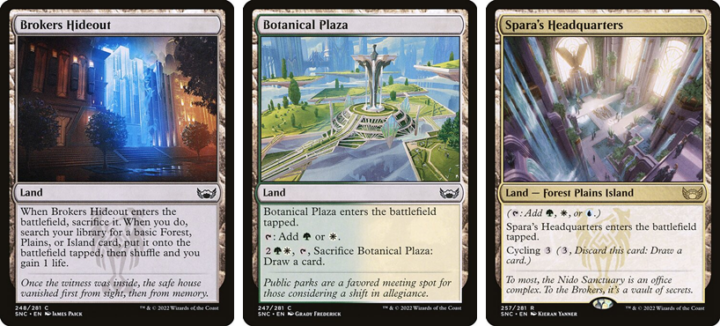
SNC had three land cycles, with two at common. The fetchlands enabled splashing, and the incidental lifegain wasn’t as negligible as it looked — especially when trying to assemble greedy decks. Having card draw mana sinks on the tapped lands, and on the rare cycling lands, also smoothed things out considerably. If things stopped there, we might have still had a decent format.
However, each shard had its own common creature that could provide further mana fixing, and a late game mana sink for when your mana situation was stable. When you coupled those with the 33 cards that made or use treasure in the set (many being commons with incidental treasure creation), you ended up with too much fixing.
The end result was an indistinct format that struggled to carve out an identity. A more tangible example is Strixhaven, where strong fixing meant the weaker archetypes suffered from seeing fewer of their crucial uncommons and rares, because the stronger color pairs could splash so easily. Zach Barash has an excellent rundown on treasure’s impact on Limited, which you should check out for more on this subject. For now, let’s turn back to Commander.
What has Treasure Done For Commander?
As we’ve seen with recent Limited sets, too much fixing has a net negative effect on the enjoyability of these formats. Treasure contributes to this problem, sure, but it also helps a lot to make sets playable.
This is no more evident than in Battle for Baldur’s Gate, a set in which Treasure is the glue that holds together the disparate worlds of Limited and Commander. CLB was a really great set to draft and play with, and it owes a lot of that to having accessible Treasure for both fixing and ramping purposes.
Treasure has been a boon in Commander, too. Colors that ordinarily struggled with ramping suddenly had access to incremental advantages. Stapling treasure to card draw spells in red has helped the color keep things moving.
Smothering Tithe, while arguably salt-inducing, has definitely helped white decks to gain some explosiveness and hit those crucial two-spell turns, with mana to spare for holding up protection and tricks. Goldvein Pick is one of the best budget equipment, owing to the fact it ramps equipment decks through attacking, which is the natural game plan of the deck.
If we look at Commander five or six years ago, it’s a different landscape. The cost of ramp, historically, has been taking crucial turns off, not deploying creatures or doing anything else that’s meaningful. It’s one of the reasons Sword of the Animist broke out as a lynchpin of non-green white decks. It helped white (and arguably other non-green colors) gain an advantage in land count while progressing their game plan.
Part of what made it so popular was the prevalence of artifact sweepers. Mana rocks used to be a little more risky than in today’s faster paced format with more single target removal.
Sword of the Animist is still popular today, but white decks are now arguably second best at ramping lands due to the emergence of cards like Archaeomancer’s Map and Deep Gnome Terramancer. When you add the likes of Smothering Tithe, colors like red or black, or treasure making artifacts, you also get access to treasure, too. White is in a much better place than it used to be, and in multicolor decks, can now claw back the majority, using other colors as a support color.
Treasures have also spawned new spins on old archetypes. Rakdos Treasures is one such deck that solidifies Rakdos as a color that can do artifact decks too, thank you very much. I’ve also personally enjoyed Wheel Reanimator decks that abuse Smothering Tithe to fill a graveyard before taking big turns.
While Treasures have evened the playing field in some ways, they’ve also further broken already abusable strategies. “A rising tide lifts all ships” is a phrase often used to explain how, much like in the macroeconomic sense of the phrase’s origins, designs that help all decks help lesser decks too.
It also works in the opposite way, though. We already talked about how easy to splash Smothering Tithe is, but that card isn’t the only offender.
We Need to Talk About Dockside
There’s not much I can say about the power or ubiquity of this card that hasn’t already been said. Dockside Extortionist was a mistake, in my opinion. Is it worth banning? Eh, maybe. There are arguments on both sides.
One comparison point I’m fond of is other explosive sources of mana, like Jeska’s Will and Gaea’s Cradle. They are both problematic in the same ways as Dockside, even if they do have a ceiling and/or require more setup, respectively.
Dockside is at the heart of many combos and, outside of Thassa’s Oracle, has probably made the biggest impact on competitive EDH of any card printed in the past five years. It combos with the common cold, and it’s an easy wincon in countless decks across power levels.
Beyond combos, Dockside ramps a player so much that they’re turns ahead in casual Commander. For a while, it’s true — it wasn’t so great at casual tables, especially in playgroups that hadn’t fully “rotated” toward the future of Commander, meta-wise.
The aforementioned rising tide also helps Dockside increase in potential at lower power tables, though. With all of the incidental treasures and pushed mana rocks lying around, this thing doesn’t only break parity in cEDH anymore. It’s able to produce enough Treasure to leapfrog the table very early on in the game.
Dockside is fought over, cloned, reanimated and flickered just as much as previous offenders Prophet of Kruphix and Primeval Titan. It’s gotten to the point where I choose not to run it in casual decks because I don’t want someone else to win with it.
Is Dockside fair in Goblin tribal? What about Pirate Tribal? What about in Boros decks? Try as you may to justify running it, it’s hard to do so with a straight face. Even if White doesn’t get treasure anymore, but Green does. Bootlerggers’ Stash was divisive not because of the power level of the card, but for the apparent dissonance it showed between our expectations and the direction of color philosophy in R&D.
Treasure Doesn’t Need Dockside to be Broken
The thing is, as much as Dockside is viewed as an outlier, Treasure doesn’t need Dockside to be a force to be reckoned with. My most recent brew uses Burakos, a card that can easily make four treasures a turn while progressing the game state.
I chose to pair him with Guild Artisan. Together, that’s six treasures in one attack step with a full party. The game plan of the deck is to burn opponents with Reckless Fireweaver, Marionette Master and Mayhem Devil while burying opponents in value.
My deck doesn’t run Dockside Extortionist. My deck doesn’t even run mana rocks outside of Sol Ring and Sol Talisman (and that’s for the cascade trigger from Flamekin Herald). As fellow CAG member Rebell pointed out recently on Twitter, not every deck needs to focus on ramp or play ten plus mana rocks.
What makes this Rakdos treasures pairing so strong is that the explosive mana generation is a byproduct of the deck’s overall strategy, which is to use artifacts to burn opponents out. When explosive mana generation helps establish a win condition it’s bad enough.
But when explosive mana generation is the win condition? I think we’ve strayed a little far from God. Just add Harmonic Prodigy and Rionya to the board, and there’s more treasures than you could ever need.
An Offer You Can’t Refuse
Three of the last Commander decks I built have seen Treasure play a huge part — the other two being Dihada, Binder of Wills and Miirym, Sentinel Wyrm. We have guides on those, if that’s your thing, here and here.
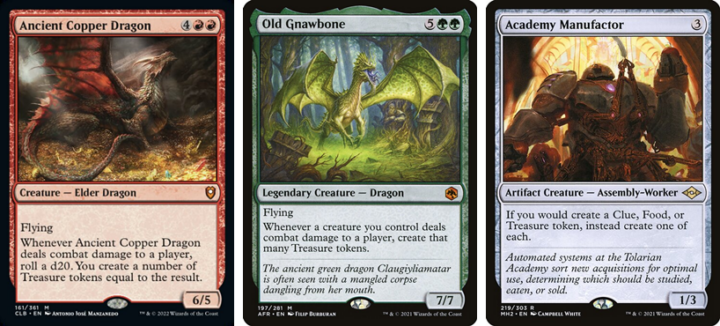
Ridiculous mana generation seems to be the end-game for modern haymakers, and it’s hard to feel anything but suspicion that this is the format being carved out; an artificial rotation to a Commander format with games that end, not with a bang, but with suffocation under intense and explosive value.
It’s not the incremental advantage of 1v1 Magic, but a race to see which player can reach the higher epochs first. Commander in 2022 is researching laser weapons while your opponents haven’t hit the Renaissance.
The problem is Treasures are a cat let out of the bag. They’re here to stay. Even if we banned the biggest offenders, we’d still be left with a format forever changed by access to easy speed boosts and mana fixing. We’re playing Rainbow Road all the time, so you best get used to it.
Is there a way to stem the tide? More cards like Sardian Avenger aren’t just needed — they feel necessary. I’d like to see more cards that hose treasures without hosing other strategies; as much as Stony Silence answers treasures, it screws the Voltron player pretty hard, too. There’s something else that could be done though, but I’m not sure Wizards would be bold enough to actually do it.
Giving Treasure an errata to say the token “enters the battlefield tapped” might be the best solution we’ll ever get. Wizards has shown inclination to this with cards like Gala Greeters, which makes tapped treasure. The main issue with this is in balancing for Limited while also designing for Commander. But I trust there are enough great designers to make this happen, and I trust we can have great draft formats, even with tapped Treasure.
Commander is a great format, but it must be acknowledged that Treasure has changed it forever. Making it come in tapped would break certain combos (and not in the way you want). It would also give the format some much needed breathing space, and potentially offset the negatives that come with treasure.
Would it make some incidental cards worse? Absolutely, but it could also fix a lot of emergent problems without the need for piecemeal bannings that don’t actually solve a wider issue. Rule 0 can sometimes feel like a crutch, especially when it comes to balancing pods for casual gameplay.
Keep in mind that that’s exactly what it’s for — balancing the game experience. As will always be the case, the conversations pre and post-game evolve, and talking explosiveness is one angle that might be worth covering.
There are lessons to be learned when it comes to fixing in Limited formats, but when it comes to Commander? Treasure doesn’t need Dockside to be broken. It’ll be interesting to see how the format looks in another year or two.

Kristen is Card Kingdom’s Head Writer and a member of the Commander Format Panel. Formerly a competitive Pokémon TCG grinder, she has been playing Magic since Shadows Over Innistrad, which in her opinion, was a great set to start with. When she’s not taking names with Equipment and Aggro strategies in Commander, she loves to play any form of Limited.

